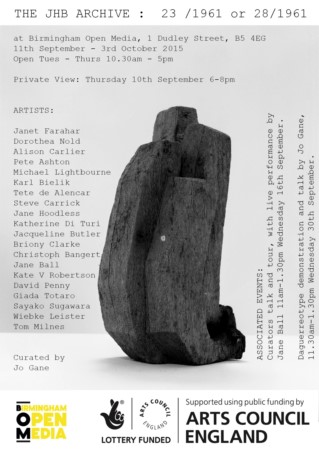
Lost Sculpture : The JHB Archive
THE JHB ARCHIVE : 23/1961 or 28/1961
23/1961 or 28/1961 is an exhibition inspired by the possibilities of a missing sculpture made by Julian Henry Beck (1914-2012) a Midlands based artist, engineer and photographer. The sculpture was purchased by Nuneaton Museum in the 1960s and accessioned into their permanent collection but has since disappeared, leaving behind only a truncated record of its description and location.
The artists included in the exhibition were selected from an open call that invited responses to make new works based around the data available about the sculpture.
Janet Farahar
Farahar’s embroidery offers a way into the exhibition, depicting the accession record, becoming unraveled as it is physically unpicked in order to be interpreted in a variety of ways.
Dorothea Nold
Having been aware as aware of the whereabouts of JHB’s original sculpture for several years in a Garden in Germany, Nold took this opportunity to return it to the UK. Shipping was arranged for this exhibition but the work has once again gone missing in transit.
Alison Carlier
This sound installation takes as a starting point the dialogue between Beck and the writer of the accession record which questions the material of the sculpture being Mahogany or Walnut. A Mahogany veneered speaker thus has a discussion about the qualities of this material whilst a Walnut veneered speaker gives a description of it’s material. Two walnut and mahogany guitars in the large veneered plinth have a gentle face-off, which is appropriate as Beck also made Guitars as a hobby.
Pete Ashton
Colours in this video are drawn from a Google image search which looks for the main terms within the accession record and then draws out the main colour from each image, taking the idea of searching for something that is lost and transferring it into a work which co-incidentally bears a striking resemblance to a previously unseen work by Jo Beck.
Karl Bielik
The negative space in the centre of Char offers a visual metaphor that forms an interesting dialogue with the drawing and photogram that are placed near to it.
Tete de Alencar
This drawing around a shadow is reminiscent of Butades drawing as described by Pliny that is often quoted as the first Photograph and depicts an absence.
Steve Carrick
Fractions of mahogany and walnut are suspended and fragmented within the acrylic bin bag, suggesting perhaps the sculpture has been disposed of.
Jane Hoodless
Hoodless’ work offers a playful account of where the sculpture could be hiding.
Katherine Di Turi
The obscured images of sculpture hint at what the work may have been.
Jacqueline Butler
This colour photogram shows a trace of an object that was once present.
Briony Clarke
Clarke’s sculpture illustrates materials that could have been used to create Beck’s missing work.
Christoph Bangert
Here the accession record is converted to ASCII code, translating the symbols of the letters to lines that are then drawn.
Jane Ball
This performance based work creates a dialogue between an Artist, Engineer and Photographer using Google documents that will then be used as the basis for an archivist to reconstruct the sculpture whilst remaining in the gallery, laser cut into Walnut and Mahogany.
Kate V Robertson
The black tape and screws from the accession record are the source for Robertson’s interpretation of the piece.
David Penny
The relationship between image, object and description are unpicked in this work, which uses 3D printing techniques to create a new version of the sculpture.
Giada Totaro
Cutting edge holographic techniques have been developed through a partnership with Maker Monday to create this ambitious technical artwork which functions as a phantom sculpture.
Sayako Sugawara
The accession record is translated backwards and forwards through Google translate across several languages that are familiar to the artist until it no longer reads in the same way.
Wiebke Leister : Corner Piece (framed object from four sides)
Approximating in-the-round approaches of 1960s modernist art, this work presents a meeting point of photographic documentation of a sculpture and photography as a sculptural object in four side views.
Tom Milnes
Paper sculptures are created using a combination of software such as 123 Catch, Blender and Pepakura that distort objects associated with JHB’s Archive.
Curated by
Jo Gane : Shadow Archive
The singular accession record that inspired the exhibition becomes 20 contradictory and truncated records of artwork.